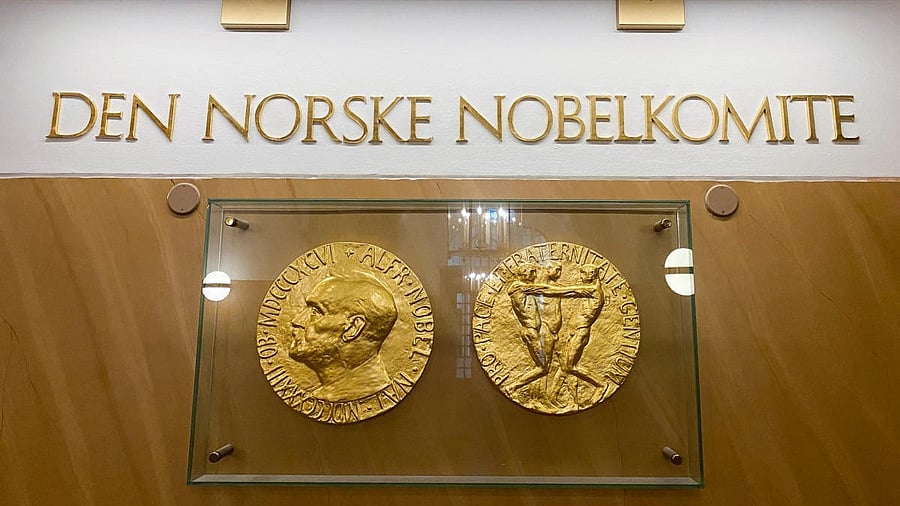
Nobel Prize medals replicas are displayed inside the Norwegian Nobel Institute.
Credit: Reuters
Three economists—Prof Joel Mokyr, Philippe Aghion, and Peter Howitt—were awarded the 2025 Nobel Prize in Economics on October 13 for their groundbreaking research on innovation-driven economic growth. Their work serves as a lighthouse for countries seeking resilient and sustainable development at a time when economic uncertainty and inequality are on the rise globally.
Understanding this year’s Nobel recognition is especially important when the world economy is becoming increasingly protectionist, global trade is disrupted by tariffs and non-tariff barriers, knowledge sharing is under scrutiny, and geopolitical tensions are escalating.
Prof Mokyr received half of the prize for his seminal research, which explains the conditions necessary for long-term economic expansion driven by technological advancement. His work explains how scientific innovations lead to new technologies, which in turn spur further research -- generating an ongoing cycle of innovation that supports sustained growth. Mokyr demonstrates that economic progress is more likely to occur in societies open to new ideas. He argues that before the Industrial Revolution, people understood how things worked but not why. The Scientific Revolution of the 16th and 17th centuries changed this, as scientists began conducting rigorous experiments and measurements to answer both how and why. This shift, he notes, nurtured originality and creativity — and laid the foundation for modern economic growth.
Professors Aghion and Howitt shared the other half of the prize for their groundbreaking 1992 work that formalised the concept of “creative destruction”. This process of creative destruction occurs when a new product enters the market due to innovation, and existing products lose market share. The innovation is creative since it represents something novel. However, it is harmful for those companies whose technology becomes outdated, as they lose out to competitors. Prof Aghion’s research has helped many countries’ governments promote more innovation while increasing healthy competition.
In the meantime, his long-time colleague, Prof Howitt, was involved in developing a strong, formal framework based on Prof Joseph Schumpeter’s concept of creative destruction, which forms the foundation of modern growth economics. Two laureates translated Schumpeter’s concept into a mathematical framework through endogenous growth theory, demonstrating that sustained economic growth is not driven by external causes but may be generated by innovation, education, and research originating within the economy.
Last year’s Nobel Prize recognised three institutional economists for their groundbreaking work on how formal and informal institutions shape national prosperity. This year’s laureates have deepened the conversation, focusing on innovation-driven economic growth and exploring why some countries are able to foster innovation while others lag behind.
How innovation transformed the UK and Sweden
The three laureates’ work also helps explain why industrialised nations, such as Sweden and the United Kingdom (UK), have enjoyed remarkably stable long-term economic development. Between 1300 and 1700, new ideas and inventions in these countries had little lasting impact on economic performance and growth. However, by the early 19th century, both nations began to experience sustained economic growth in GDP per capita. Except for a few major downturns and crises, such as the Great Depression in the 1930s, growth rather than stagnation became the new normal. This pattern of consistent spreading out, averaging around 2% per year, immediately spread across the majority of the industrialised world, renovating economies and raising living standards. Their research has helped us better understand how innovation developed, what enabled it, and how society’s receptivity to new ideas made a big difference in bringing about difference. According to them, the UK’s early steady growth was attributed to the large number of highly qualified engineers and craftspeople residing there.
The three laureates’ research is particularly relevant to India, which has experienced a significant increase in per capita income over the past few decades, following years of stagnant growth. India’s success in digital technology, medicine, and renewable energy can be attributed to technological innovation and improvement. However, we fall short in prioritising research and development, innovation, and high-quality research intensity. This can be easily recognised while looking at a few critical economic indicators. Sweden is ranked second globally, whereas India is ranked 38th out of 139 economies for the Global Innovation Index 2025. Similarly, in 2024–2025, Sweden spent 3.6% of its GDP on R&D, a significantly larger percentage than India’s 0.64%. The sustainable economic growth of many developed countries is driven by innovation and their emphasis on technology.
In its labs and university teaching, India must foster a true culture of curiosity and promote critical thinking and unconventional thinking. If not, we will not be able to use our youthful brains and demographic dividend to spur innovation. India also needs to promote innovation in rural economies and agriculture—sectors where the country holds an absolute advantage, as suggested by Adam Smith and Ricardo’s theories. It is essential to support local enterprises and develop more processing industries within the rural economy. These sectors have largely failed to benefit from innovation and are in urgent need of a transformative solution. India needs to ensure the promotion of innovation, reduce market dominance, reduce the asymmetric information gap in innovation and facilitate the transfer of knowledge.
(The writer is an associate professor of economics at Manipal Academy of Higher Education, Bengaluru)